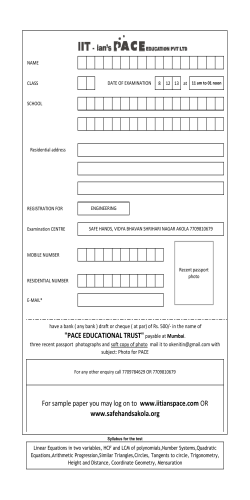
Uptake of Ammonia by Four Aquatic Plant Species Team Bangladesh
Uptake of Ammonia by Four Aquatic Plant Species Team Swapnodorshi Bangladesh Content Project Location The Research Team Rationale for Research Existing Knowledge – Observations Objectives Hypothesis Experiment Details Results Lessons Learnt Acknowledgements Project Location Map of the World Map of Bangladesh Map of Chittagong The Research Team Researchers Md. Abdullah Al Emon Md. Rashed, Md. Jobaer Uddin Rezaul Karim Mentor Enayet Hossain Research Associates Tasmeena Sultana Yousuf Md. Afnan Hossain Name of the School: Alipur Rahmania High School Class: X Rationale The humankind is living in a world of diminishing resources. Soil, water, forests, plants, and animals are renewable resources as long as they are judiciously used. 97% of the water on the Earth is salt water, and only 3% is fresh water. Of the 3%, a two third is frozen in glaciers and polar ice caps. The remaining unfrozen freshwater is found mainly as groundwater, with only a small fraction present above ground. Rationale The world's supply of clean, fresh water is steadily dwindling. Major water sources are getting polluted. The survivability of the life systems in many water bodies is in jeopardy. Impact of water pollution on human is very apparent. The depletion of Fresh water resources could very well create the resource crisis of the 21st Century. There will be wars for water rather for oil. Rationale Rapid population growth is adding to the water problem. Environmentally friendly technologies for water management are needed. Recycling wastewater generated in households and discharged by industries will reduce water scarcity. Ammonia is a major contaminant in many industrial discharge, agricultural runoff, and human and animal waste. It causes eutrophication in lakes and other water bodies, and it is toxic to aquatic organisms. There is need for ammonia removal from water. Observation Some plant species have the ability to uptake, tolerate and even accumulate heavy metals and other toxic substances from soil and water. They uptake these contaminants through their roots and concentrate them in roots, stems and leaves. Hypothesis Aquatic plants will uptake ammonia from wastewater and, thus, clean the polluted water. Objectives To find out whether aquatic plants can uptake ammonia from water. To find out what plant species can remove ammonia more efficiently from water. The Experiment An experiment was undertaken to study the potential for removing ammonium by four aquatic plant species: Water hyacinth (Eichhornia crassipes) Helencha (Enhydra fluctuans) Kochu/Arum (Colocasia esculenta) A plant with aerenchyma Plants were collected from a water body near the University of Chittagong, Bangladesh. Study Method Research: Review of literature was done about the role of aquatic weeds in wastewater treatment. Survey: Local survey was conducted from January to April 2011. Plant Selection: Four aquatic plant species were selected for the study. The plants were selected because of their apparent resistant nature. Rationale for Plant Selection: These plants were seen growing vigorously in a water body where the Department of Chemistry, University of Chittagong discharges chemical wastes from the laboratory. Plants for the Study Photo 1: The water body from where the plants were collected Plants for the Study Photo 2: Research team members are collecting plants for the study Plants for the Study Photo 3: Kochu (Colocasia esculenta) Photo 4: Water hyacinth (Eichhornia crassipes) Plants for the Study Photo 5: Helencha (Enhydra fluctuans) Photo 6: A plant having aerenchyma Experimental Set-up Five plastic troughs of 16-L capacity were taken. The troughs were filled with 14 L distilled water containing ammonium (NH4+ = 25 mg L-1). Ammonium chloride (NH4Cl) was used to make ammonium solution. The four test plants were readied for transfer into individual plastic troughs. The weight of the biomass plants was kept equal (60 gm) for all plants. The biomass weight was taken after keeping them on a filter paper to remove excess water. Plants were transferred to the troughs. One plastic trough was kept as a control (not plants but only ammonia water). Experimental Set-up Photo 7: Team members with the reactors Experimental Set-up Photo 8: Team members with the reactors Ammonia Measurement Ammonium concentration in water in the five plastic troughs was measured after completion of Day 1. From then onwards ammonium concentrations were measured at 3-day intervals up to Day 46. After 46 days, the experiment was terminated. BAKER TESTRIPS for Ammonium (NH4+) were used for the ammonium measurement. Ammonia Measurement Photo 9: Ammonium was measured with BAKER TESTRIPS Ammonia Measurement Photo 10: Ammonia was measured with BAKER TESTRIPS Results NH4+ Concentration, mg L-1 30 25 20 Control 15 Water Hyacinth 10 5 0 6 12 18 24 30 Days Water Hyacinth 36 42 Kochu/Arum 48 30 NH4+ Concentration, mg L-1 0 25 20 Control 15 Arum 10 5 0 0 6 12 18 24 30 36 42 Days The graph are developed with the lower values of measured concentrations 48 Results NH4+ Concentration, mg L-1 30 25 20 Control 15 Helencha 10 5 0 6 12 18 24 Days Helencha 30 36 42 Plant with aerenchyma 48 30 NH4+ Concentration, mg L-1 0 25 20 Control 15 Plant w/aerenchyma 10 5 0 0 6 12 18 24 30 36 42 Days The graph are developed with the lower values of measured concentrations 48 Summary of Results Moderate to complete ammonium removal was observed in planted systems. There was no change in ammonium concentration in the water where no plant was grown. So, ammonia removing bacteria (nitrifiers) that could have converted ammonia into nitrite and nitrate, might have been absent. It was concluded that there was no loss of ammonia due to nitrification. Changes in ammonium concentration were only on account of plant uptake. Helencha worked the best for ammonium removal. Further studies may be needed. What Have We Learnt Aquatic plants can be used to remove ammonia from polluted water. The potential of different aquatic plants to take up ammonia from water is not equal. Acknowledgements We are thankful to: 1. WateRediscover International for organizing this program 2. Dr. Achintya Bezbaruah Assistant Professor of Civil Engineering North Dakota State University 3. Mohammad Jahidul Anar Environmental and Conservation Science North Dakota State University 4. Tasmeena Sultana Yousuf 5. Md. Afnan Hossain THANK YOU ALL
© Copyright 2025





















